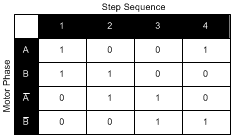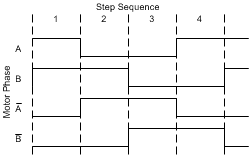SLVA767A September 2016 – December 2016 SN75469 , TPL7407L , TPL9201 , ULN2003A , ULN2003B , ULN2003V12 , ULN2004A , ULQ2003A , ULQ2003A-Q1 , ULQ2004A , ULQ2004A-Q1
4.2 Full-Step Operation
The full-step mode of operation is the most commonly used way to drive a stepper motor, as it has improved torque over the wave drive method and constant torque relative to the half-step method. The wave drive mode would likely be used in applications where increased torque is required.
For this mode of operation, two phases of the motor are activated simultaneously to provide an additional attractive force relative to the wave drive method, while still maintaining the resolution of the wave drive method. Figure 11 and Figure 12 describe the step pattern required for the full-step method, while Figure 13 provides a pictorial representation of the motor steps. Depending on the motor, each step in the sequence will rotate a defined angular distance. Figure 13 represents a motor with 4 steps per revolution, but many common stepper motors will have 32 or 64 steps per revolution; furthermore, others can have even higher precision. Each step for the motor in Figure 13 spins the motor 90°. Note that the full-step method has the stator attracted to a space between each of the phases that are activated, as opposed to the wave drive method where the stator is attracted directly to the activated phase. Because the stator is attracted to a space between two phases, there is a point where the two phases are pulling in opposite directions. As a consequence the full-step method does not provide torque twice that of the wave-drive method (despite twice the power consumption), but rather more equivalent to 1.4x the wave drive method.
 Figure 11. Full-Step Logic Table
Figure 11. Full-Step Logic Table  Figure 13. Full-Step Motor Coil Sequence
Figure 13. Full-Step Motor Coil Sequence  Figure 12. Full-Step Timing Diagram
Figure 12. Full-Step Timing Diagram